On Monday, I showed you the little reticello sampler I’m dabbling with. It’s an exploratory thing, just for my own information at this point. Many of you have asked if this will be in the Stitch Snippets series this year. No – no no. Oh no. Nope! That’s not to say it won’t develop into something else, but the Snippets for this year are pretty much planned out already.
This piece is really just for my own information, learning, trials and errors, and so forth.
I have a question I want to ask you about it, though, so I’ll do that at the end of today’s article.
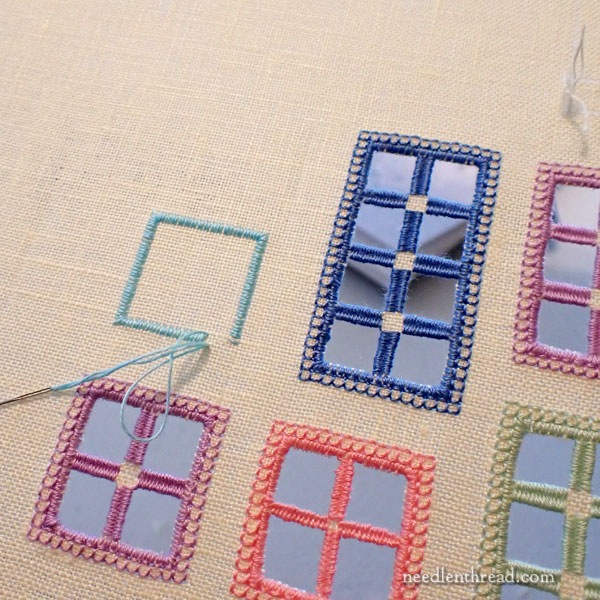
My sister asked the other day how my Easter Windows are coming along, and that name has stuck on this project. It’s not intended to be any particular theme, though. I’m only using colored threads so that I can clearly see the interaction of the thread and the fabric as I piddle about. If I were doing this in earnest, I’d be using a thread that matches the ground fabric for this part of the work.
Overall, I’m having fun! I’ve made some good mistakes, which keeps the whole process realistic.
I like making mistakes when I start to delve into this kind of exploration. It helps me get the hang of the whole technique much better. Once you’ve had to work your way out of a mistake and do some troubleshooting, you end up knowing the process so much better.
By the way, reticella (with an “a”) and reticello (with an “o”) are used interchangeably for this type of cutwork lace. If you want to know more about this type of Italian cutwork lace, you can read about it here. There are loads of resources online – look up either “reticella” or “reticello” and the world of Italian needle laces will open up before you!
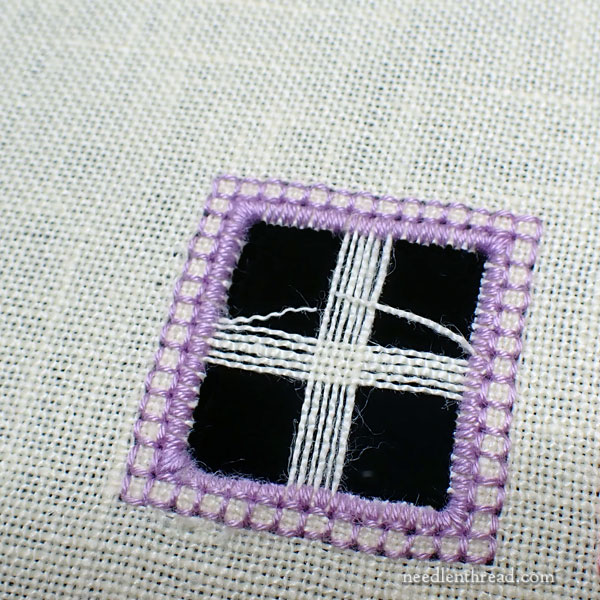
Here’s a typical mistake in this type of cut thread work. I cut the thread. Unfortunately, it was the wrong thread.
This is the type of mistake that intimidates a lot of stitchers. Whenever cutwork or drawn thread or something similar comes up, I often hear statements like, “I could never do that. What if I cut the wrong thread?”
Well… it really is just a thread. Cutting it is not going to end the world. It can be repaired – and pretty easily, too.
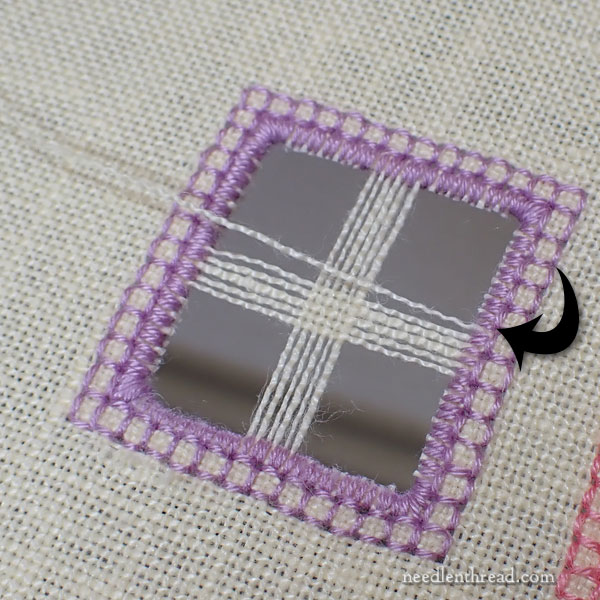
To repair this, I removed the cut thread entirely, up to the edge of the motif.
Then, I took a thread from the edge of the fabric – one that runs parallel to the thread I just removed – and I anchored it in the back of the stitches on the sides of the window by running it under the backs of several stitches and hitching it around the final stitch, to make sure it was good and secure.
Then, I brought it out on the edge exactly where the original thread should have been.
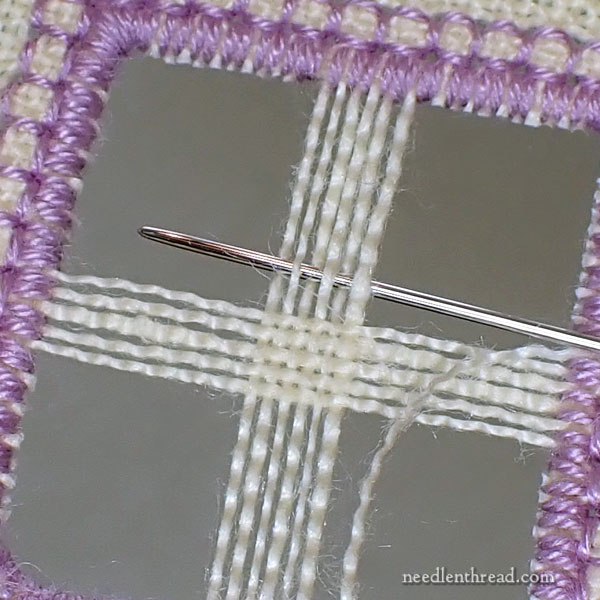
Consulting the thread below to make sure I had the right sequence (in this case, under-over, not over-under), I wove the new fabric thread in place…
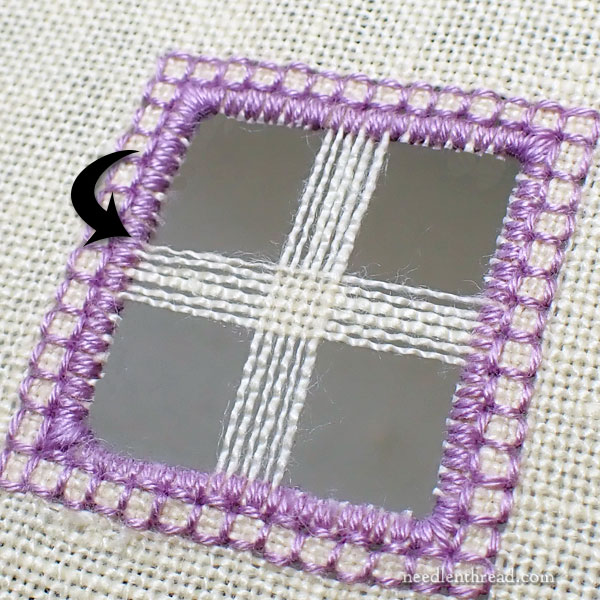
…and anchored the thread on the opposite side, where the original thread had ended.
Depending on the type of drawn thread work you’re doing, and how you manage your cut threads in the work, there are different ways of making such repairs. This is one of the easiest, and it takes barely any time at all.
See? Nothing to be intimidated by!
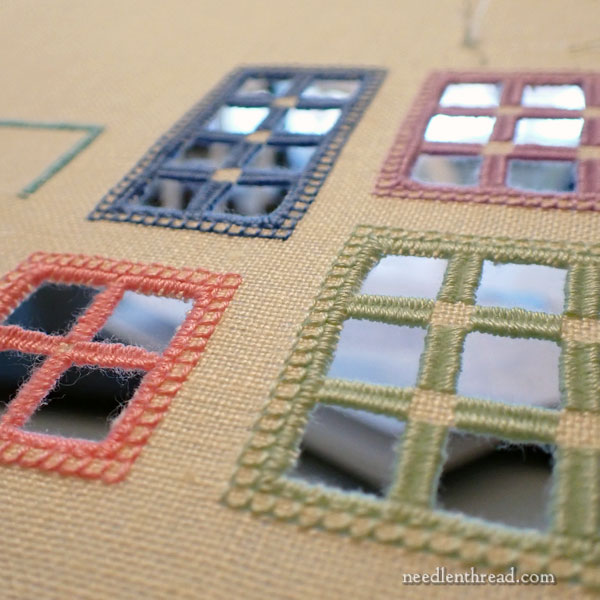
I really do enjoy this type of work, but I don’t do it very often. I’m happy to be able to enjoy it again for a little while!
To put things, size-wise, in perspective, I should mention that the little purple window that I just fixed is small. The opening is less than an inch square. The whole window, frame and all, is not quite 1.125″ square (one and one-eighth inch). The fabric is about 37 threads per inch.
Question!
I’d like to know if you would be interested in some excellent Italian books on this technique. I’m considering bringing some in. I’m all ears, if you’re keen on the idea! You can drop me a line, or you can chime in below.







Yes please – I would love to hear about books on reticella, as long as they have English instructions and lots of photos.
Reticello book recommendations? YES please!
I’d love some books on reticella and reticello. This is something I want to try.
Yes to some reticella books! Trying to do 17th Century Whitework Sampler from Trisha Nyuen. I need help!!!!
Maybe we can encourage Gary Parr to get his project out!
Let me say that I’m totally excited about some books on reticella(o). I want to be playing right along side you, but will try to wait patiently as you explore and possibly get some books on the subject! I’m really hoping that there is a lot of interest in the topic!
Best Regards,
Debra
I’m working on a reticella piece now. I would love to have some books.
If you were to offer a little series on the techniques in the Italian books, I would almost certainly want to buy them. I don’t necessarily mean tutorials, which might be redundant with the books, but perhaps pictures like the ones in this post and suggestions for specific kinds of samplers like your reticello window.
Depending on the complexity of the technique and the quality and quantity of illustrations, an embroidery book in another language can be just as useful as a book in one’s native language.
Yes, I’d love to know more about Reticello books. Just purchased some and can’t wait to dive into them and a project.
Miriam
Yes please!
Interested in reticella books as Kong as there are enough pictorial or English instructions to make out how to do the more advanced techniques. It seems a lot like hardanger.
I purchased 3 books on Reticello from an Italian designer, Giuliana Buonpadre. The books I purchased directly from her included Il Reticello , Fior Di Reticello and Herbarium, which is my favorite. I had to purchase them directly from her in Italy because I could find no other source for them except from Australia, which was prohibitive in shipping costs. All three books are printed in 2 languages – Italian and English. I love her use of color in an otherwise white on white method. She also brings her designs outside the gridwork, making it just fascinating. In my opinion, she’s taken this old technique and given it a modern twist.
Yes, I’ll be carrying most of her books here in my shop, beginning very shortly. I’ll be listing them within the next week.
I would be interested in a reticello book if it had English translation
These so remind me of doing Hardanger. I have never done that in color though and I really like it.
I would love to have some books on reticello. I took a class once but it seemed so fast paced that I was overwhelmed. I did finish the project with good results but would like something that would refresh my memory. The joy is in the stitching.
interested in books on Reticello
Hi Mary — The “Easter Windows” are lovely in the colored threads. You wrote, “If I were doing this in earnest, I’d be using a thread that matches the ground fabric for this part of the work.”
But the windows are charming in the pastel colors! Your sampler immediately brought to mind a years-ago visit to Rainbow Row in Charleston SC (a historic area with a stretch of pastel-colored row houses).
Thank you for your web pages. I’m not an embroiderer, but your blog is so much fun to read (and I learn a lot).
Best,
Kathy
Thank you for addressing reticella embroidery, Mary. I have always admired the effect and would like to learn more. Your tutorials and books you may offer are welcome by me.
Yes, I would love to see some books on reticella. It would be great if they were written English or have some instructions that were understandable. Sometimes illustrations and photos are all you need. But written instructions can be very helpful.
Yes…..I would be interested in some more information of the Reticelli Sampler. Since I’ve done quite a bit of Hardanger in the past, I would even be interested in how the techniques are similar and how they differ….
karen
I am interested in books on reticello!
Yes, please share books that you feel would be of value to us, Mary. I have done Hardanger for years and think that I would also enjoy doing this type of needlework.
Your cutwork is beautiful. I like the idea of reticella but would like to see it in a more modern setting. But maybe that is not the point of this type of embroidery.
Books! The more the merrier. Whether I try it or not, needle laces fascinate me, especially reticella. Punto in aria, indeed!
FWIW, while Punto in Aria are very similar, and it can be hard to tell them apart. You can do them with some of the same patterns.
However, punto in aria is generally considered to be lace as it is created “in the air” or “from nothing.” Reticella/o is considered an embroidery technique because it begins with a ground fabric.
I’d definitely be interested in some Italian books!
YES!!!
I would probably enjoy the books but would be reluctant to buy them for a technique I might not use, since they are probably expensive. I think I would love it more if you did a project with instructions on the technique and sold a kit (if I can ever manage to get one of your kits before they sell out ;)!!
Yes I would.
Mary, I believe I may have the books you are talking about. They are lovely. I didn’t purchase all of her books, but did purchase 4. I might be interested in one or 2 others, depending on what you have. I’m not sure if my question posted on the last post or not, and I have to say I’m disappointed this won’t be a sort of demo/stitch along, I was soooo hoping. Sigh. Ah, the disappointments we must endure in life. LOL. At any rate, may I ask, what are the stitches around the edges called and do you have demos for those. (the ones that anchor the window edges). Thanks much.
Hi, Carol – Not to say I won’t do a stitch-along eventually, or at least a project that I share my progress on, and my tips and troubleshooting (which is actually what it is turning out to be, anyway). The technique is fun, and Giuliana’s books are really fascinating, when it comes to her interpretation of Reticello into more modern forms. I love them! The stitches around the edge are simply satin stitch (the inside round) and four-sided stitch (the outside round).
I’m not sure if I am interested in this Italian technique. I have been Very interested in Hardanger, since my roots are Scandinavian, and this technique looks similar? And maybe not as complicated? I have trouble keeping a correct count when I have tried Hardanger. Could you show us some examples of this in all white, rather than the colors that you are using for illustration? I actually think it looks very pretty in colors, however.
Thanks for all you do, Mary!
Karen
I have been teaching myself Hardanger for the past year and information is difficult to come by. Reticello is very similar, and I would be interested in books on the subject. Thank you for the article on repairing cut threads. Thank you always!
EGA has a new GCC – Reticello Needlebook.
https://egausa.org/courses/reticello-needle-book/
Heartland Region has a group doing it right now – our first zoom meeting is tonight.
I have been going down the rabbit hole on Reticello and want this book
Vol. 5 – Fior di reticello by Giuliana Buonpadre
https://www.filofilo.it/eng/embroidery-books/vol-5-fior-di-reticello-reticella-2
How did you turn the four-sided stitch
I am so jonesing for her book(s)!
With the 4-sided stitch, if you always keep the stitches moving in the same direction in relation to the frame, then the only difference as you switch direction is the presence of one backstitch. Yes, those are the books.
Mary, listing references is always a good idea. I have played with this type of lace over the years but not have completed anything yet. I always got
bored which is a pity. Cataracts have interfered in the past but several of the designs I was working on are calling to me. Your exploration has made their voices louder. One of the current small designs available is from Inspirations magazine and is available for downloading which I plan to get once I have finished several local EGA projects.
Do have fun with the learning! Your idea of using colored floche or threads is really clever! While the end product will not be traditional the learning process should be satisfying.
Your method of repair is the one most of us learned when exploring Hardanger
To trim the fabric threads really close to the edge of the opening, notice the way it tilts. Cut those (every other one) that tilt up towards you , the turn the piece over and cut the ones that face you now. You can snug your scissor tips right up to the stitched edge. To aid in this process, I pay attention the the orientation of the first stitch so that I cut the first thread (and not the last) from both sides.
I have been doing this for a long time when cutting Hardanger openings. Really sharp fine tipped scissors. (Dovo 44 or similar)
Si por favor, así como la Tela e hilos a usar, cuesta mucho conseguir todo esto. Estaré atenta para cuando diga que ya los tiene. Bendiciones Mary.
I think that would be a good idea. I trust how you review books, picking ones that are good at what-they-do. Input — look into Karen Quickfall’s book, Ruskin Lace, A Complete Guide. She is a protege of Elizabeth Prickett.
Good reticella books are hard to find. I bought mine from Italy. Marie Suarez has a nice one in French. Most are in Italian and do not go into great detail, so you are at the mercy of (hopefully) good photos and illustrations.
Your work is beautiful! And inspirational. I’d love to try it if I can find the time and have your expert guidance
I would love your book recommendations on the technique of Reticella! Thank you!
Mary, I would be very interested in seeing some books on Reticello. I am starting a correspondence course today through EGA on Reticello. We will be stitching an initial for a needle book cover.
YES! I’d be interested in further Reticello work and books, especially any that I haven’t stumbled onto yet. In searches I quickly found and bought several by Laura Mazorati – all in Italian – but the close-up photos are numerous and good, so language is not a problem. But are there others available? In more than one language?
Best wishes, SKE
Reticella, all Whitework also with color, are my favorite types of embroidery! I’d love everything you could provide!
Your windows look like they have glass in them: very pretty! But I am looking forward to seeing them filled with embroidery.
Hi, Mary!
Yes, I am interested in useful books on Italian needlework, in particular, Assisi and reticello. I don’t mind if they are in Italian instead of English, because I find that between the illustrations and online translations, I can usually understand enough to be getting on with. And I would like to expand my embroidery skills to include more cutwork. Thanks for bringing it up and for sharing your stitching exercises with us. I didn’t know how easy it was to fix a mistake in cutting, and that knowledge gives me more confidence to try it!
Are you looking for how-to books for Assisi or pattern books? There are scads of pattern books from the q6th and 17th centuries. Historically, the backgrounds were stitched in long-arm cross-stitch. They were also stutched with pulled thread.
Check out https://string-or-nothing.com/ she’s been doing a bit of Assisi work of late.
Yes to the Italian cut work books. Needs to be under $ 45.00.
Thanks Mary
I am always looking for something new to try and introduce to my fellow stitchers at a local SAGA chapter.
More about cutwork embroidery, especially how to do spiderweb openwork. Also more information on how you transfer patterns when you do multiples for kits. None of your transfer techniques seem to cover this.
I’d love to learn more about Reticello, books, snippets like the windows, anything!
Mary- I would be very interested in the Italian books on reticello. I simply adore cutwork and am always looking for inspiration. Thanks so much!
I took some private classes a few years ago in Italy. I would love some books with directions If they have great illustrations, I wouldn’t mind if they were in Italian.
I would love to explore more Italian needlelace and would welcome the chance find out about more books that are available. Please.
I’d be very interesting in hearing about the books but it wouldn’t really make sense for me to buy them from you as that would require them to cross the Atlantic twice when they’d otherwise need, at most, to cross the Channel. And international shipping prices being as they are and books tending to the heavy side as they do …. But I’d love to see your recommendations.
‘I’d be very interesting’ -> ‘I’d be very interested’ !!
Definitely interested in books on reticello.
Mary,
I have a question for you. It looks to me like hardangar. Is reticello the Italian version of the same needlework?
Not quite, but close. Reticella relies a bit more heavily on needle lace elements, compared to Hardanger as we know it today.
Yes, please. And I agree with another comment, English would be great.
Hi Mary,
I would like to buy some italian books about reticello. I am looking for Giuliana Buonpadre books, they are in italian or in french-english option. The vol.4 punti a giorno, is the first one i would buy, but they all seems to be great books!
Thank you!
Keep an eye out for them! I should have them sometime in mid-May or a little later. Thanks!
I love your Easter windows, Mary! I’ve explored the technique a bit, but have an Inspirations project (from way back) partly worked and I suddenly became intimidated and put it down. Your idea of reticella books would be really useful. I trust your reviews, so even a few recommendations would be great. I don’t live in the US and know that you don’t post to Australia (understandable!), although I could use my daughter in New York as an intermediary address if I had to. I’m looking forward to all your windows developments; please, oh please, keep us posted! Best wishes, Alison
il Reticello by Giuliano Buonpadre written in English and Italian with extremely clear diagrammatic instruction for each stitch is, in my opinion, the Bible of this stitch.
Yes, I’ll be carrying it – as well as many of her other books – here in my shop very shortly. I’ll probably start listing them at the end of this week or beginning of next! 🙂
I love and have been playing around with Italian needle lace for about a year now. I especially love. Wish I could send you my most recent completed work, but I don’t see a way.
You can attach to an email response! 🙂
Yes please! Reticello yes!
Oh please, would you? I’ve wanted to learn this technique. But good info seems hard to find. Like Giuliana Buonpadre‘s books are beautiful, but the ordering process has definitely made me hesitant to buy them.
Well, of course I’d be interested in new embroidery books! That means a “Mary review” and way more pictures than you can see on Amazon.
Would I buy one of them? Right now I’d just tell you I don’t have that much discretionary income. After I read the review? Well … maybe I can scrounge around and find the money needed. It’s an embroidery book reviewed by Mary, after all.
Yes I’m interested. I have done Hardanger in the past. This is very similar.
This is fascinating. I would like to see more. Thanks
Would love some reticella/o books!
I don’t speak Italian, but Italian text with very clear diagrams would be fine.
Hi Mary,
I’ve always had a fascination with reticello, & I’d love to try it before my sight gets too dim!! I’m teaching myself hardanger embroidery now, & I don’t believe it’s as hard as reticello.
Text in English though, with good pictures, please!
Yes! want to learn more & more. I have been very interested to learn more, and finding resources for the materials for Reticella needle lace. Thank you !
In many Italian cutwork & Reticella I’ve done directions cut from middle, pull the threads back to the satin stitch (tack them down) and then do the 4 sided stitch on top to anchor. Two good reasons for this method is that there’s not scrap threads sticking out inside and when framing you are less likely to have it unravel or pull apart if pulling too hard on stretching.
I like almost all Italian (except x-stitch). Are there any new Umbrian/Sorbello books? I have one by Giuseppa Federici–love it but I don’t speak Italian. I have to translate as I go.
Yes, this is the technique I’ve used before, too. In this piece, though, I’ve been cutting. I’ll probably dabble with several different approaches.
If you go searching museum sites for historic examples, the spelling can make a difference as to whether you get any results or not.
The V&A uses reticellA … reticello returns glassware. http://Collections.vam.ac.uk
The Met in NYC uses both … and you get different pieces with the 2 different spellings!
https://www.metmuseum.org/art/the-collection
Please introduce us to Italian books on this topic. It is a lovely technique and doesn’t get nearly enough attention, IMHO, in the U.S. The more, the better!
Yes please! I went to Laci’s and combed through 15 books on Reticella to find two that I liked and thought helpful. I’d be very interested in your recommendations! They are always so good!
Morning. Yes please , I too would love more on reticella (o) laces as well as other types. I also need to have instructions in English. Thank you so much for the offer. I am new to the website but I get on it often , daily, .
Absolutely I’d be interested in some good books. Reticella has been on my radar as a technique I’d like to learn…for a really long time. I look forward to seeing more about it here.
Links and book recommendations, are always welcome on any form of needlework. However I’m not sure I’d actually buy a book if you stocked them. My shelves are full, so many I’ve not looked at in years. Yet I can’t say I’ll definitely *not* buy a book from you. Especially since I have no local sources of buying good needlework books that I can look through before deciding yea or nay on purchasing any more.
I made a hardanger piece for my parents 50th anniversary. I was fascinated, and scared to make that first cut in the linen. IIRC, I did have to repair a wrong cut. Once the thread is replaced, it’s nearly all covered and further secured by the wrapping threads. I have no idea why I’ve never made another piece any form of needle lace.
@Susan Lewis – thank you for that tip.
I’m interested in the books on Italian needlework having dabbled some (actually quite a bit – you know how some techniques highjack your interest). I have several items and many gifts given using monks cloth and binding the edges with Italian Hem stitch so the piece never ravels.
I’m always on the prowl for new techniques books! Yes, I’m interested in the Italian ones, if they are printed in English.
I am interested in books. I’ve always loved Whitework on antique samplers! I signed up for an online Whitework class to face my fears! I’d love to hear any recommendations you have as well! I love your Easter windows and will be doing my first sampler in color for the same reasons you shared. I look forward to seeing your progress on this exercise.
I would buy an excellent Italian book on reticello! You bet!!!
Very exciting. Looking forward to the project.
Hi, yes, I would be interested in the Italian books on Reticella and doing a sampler.
Cheers, Helen Dolph
This looks very much like Hardanger.
Yes please I would love books on reticella as long as they have been translated into English and with lots of diagrams.
I would also enjoy exploring reticello techniques.
Mary, I’m very interested in any books or resources on reticella. I’m teaching myself Hedebo at the moment and, as is true of most whitework, the stitches/techniques seem quite similar.
Looks like you have tons of positive responses already but I’ll add mine to the mix too. I’d love to learn more about this type of work and seconding a few others your reviews are always helpful and interesting. But I’d particularly like to agree with RISA ENTREKIN who mentioned the project idea since I live in Australia and the international shipping is ridiculous. Between that and any book recommendations I could perhaps buy locally. I really enjoy reading your blog too it makes my day through some of these difficult times. And you explain needlework concepts in a way I understand well and connect with. Better than some books I’ve read on the subject. Thank you for your efforts.
I’d like to see a review of books. We are workin on a Whitework sampler now and it has some reticella in it as well.
Great timing.
Debra
Yes, please!!
Yes, please! I can’t seem to find a place to get a nice book on reticello and would be very interested if you carry some.